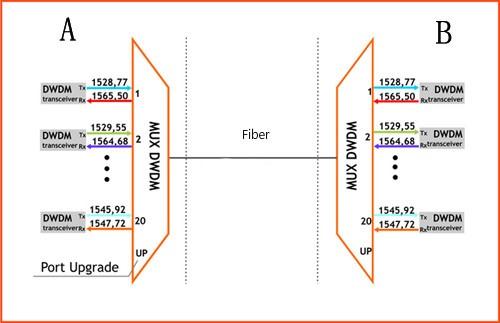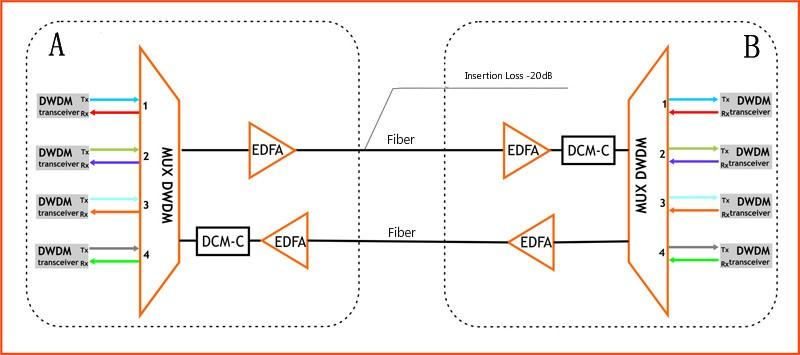Dense Wavelength Division Multiplexing (DWDM) is a wavelength division multiplexing (WDM) technique that extends the transmission capacity of existing fiber networks. It can multiplex multiple optical carrier signals onto an optical fiber for transmission and save a lot of fiber resources in long-distance transmission applications. There are two main DWDM systems: passive DWDM systems and active DWDM systems.
Passive DWDM system does not use fiber amplifier and dispersion compensator or other active assemblies, the transmission distance of this system is limited by optical module transmit power, but it has the advantage of high channel capacity, which mainly used in the high-speed transmission lines of metropolitan area network and high channel capacity.
Active DWDM system
Active DWDM is a system that includes a repeater that performs optical-electrical-optical (OEO) conversion. In addition, the system also has a number of erbium-doped fiber amplifier (EDFA), to ensure that the receiver can receive high-quality optical signals, but the quantity of erbium-doped fiber amplifier (EDFA) will be limited by fiber types, wavelength channel number, transmission rate, signal-noise ratio (OSNR) and other factors.
The link length of active DWDM system is not only related to the quantity of fiber amplifier and signal-noise ratio (OSNR), but affected by optical signal dispersion as well. Therefore, we should take the optical signal dispersion into account when designing active DWDM system, and even the dispersion compensator (DCM) can be used in the system if necessary. It need to be note that the insertion loss of fiber links will be increased if use dispersion compensator, and the transmission distance of the active DWDM system will also be affected.
Passive DWDM system VS active DWDM system
Passive DWDM system and active DWDM system has their own merits and demerits, this part will be described in detail.
Pros and cons of passive DWDM system
Cost-saving: compared with active DWDM backbone network which has fiber amplifier and dispersion compensator, passive DWDM can build the high channel capacity high-speed transmission line with a lower cost way.
Easy to use: passive DWDM is a plug and play system, it is simple and convenient to use.
However, Passive DWDM systems are also deficient in the following aspects:
Extensibility: the wavelength channel of passive DWDM system is limited, it has to use more passive DWDM devices to extend network that increase the difficulty of system management.
Pros and cons of active DWDM system
Active DWDM system supports larger quantity of wavelength channel, and thus the bandwidth is greater, the utilization rate of fiber is higher. In addition, active DWDM system is easier to manage, so that the users can adjust channel wavelength on-line without shutting down the system, and active DWDM system is easier to extend.
Compared with passive DWDM system, the longer transmission distance of active DWDM system has, and the deploy cost is higher. What’s more, active DWDM system also uses fiber amplifier, dispersion compensator and other devices, the deployment is more complex than passive DWDM system.
Conclusion
Passive DWDM system and active DWDM system holds their own advantages and disadvantages, we need to deploy the DWDM system based on the specific needs. Whichever system above is deployed, the DWDM multiplexing / demultiplexer are essential.








































































